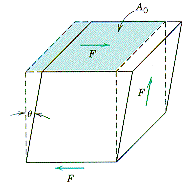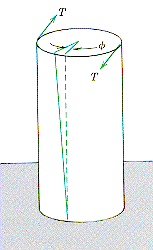|
Deforming
a material in different ways introduces additional elastic constants. If
the material has a linear elastic response the stress and strain are still
linked by a Hooke's law type of relationship, and these materials are said
to be "Hookian."
The
top diagram shows a material being deformed in pure shear. The shear stress,
t
= F/A0,
is related to the shear strain, g
= tanq,
through the "shear modulus," G such that:
t
= Gg.
In addition to shears applied to the top and bottom faces of the cube,
opposing shears must be applied to the side faces to prevent the material
from rotating.
The
bottom diagram represents a material in torsion. The applied torque, T,
causes the sample to twist about its long axis (a counter-torque being
applied by the fixed base of the sample). The twist is associated with
a position dependent shear strain in the sample, the angle f
being dependent on the height, x, above the base and the material displacement
at a given height being dependent upon its radial location. For this case:
g
= r(df/dx)
for small f,
and defining (df/dx)
= q
gives the elastic relationship: t
= Grq.
It is seen that the maximum shear stress in the sample occurs at its surface,
and that the stress increases linearly from zero at the center of the shaft
to this maximum value. |
|
|
|
|
|
|
|
|
|
|
|
|

